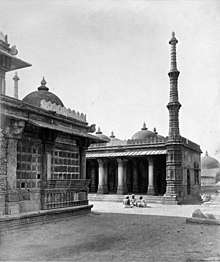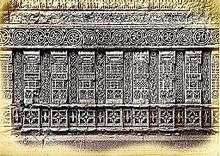Rani Sipri's Mosque
Rani Sipri's Mosque (Gujarati: રાણી સિપ્રી ની મસ્જીદ) also known as Rani Sipri ni Masjid or Masjid-e-nagina, formerly known as Rani Asni's Mosque, is a medieval mosque in the walled city of Ahmedabad, Gujarat in India. This mosque was commissioned in 1514 by Queen Sipri, the Hindu wife of Mahmud Begada, a sultan who ruled Gujarat. It is also known as Masjid-e-Nagina (Jewel of a Mosque) because of the intricate jali carvings on its walls. In 2006-7, the Ahmedabad Municipal Corporation under BJP leadership proposed demolishing part of the monument in order to expand a road.[1]
| Rani Sipri's Mosque | |
|---|---|
 Rani Sipri's Mosque | |
| Religion | |
| Affiliation | Islam |
| Location | |
| Location | Ahmedabad, Gujarat, India |
| Geographic coordinates | 23.017222°N 72.590278°E |
| Architecture | |
| Type | Mosque |
| Style | Islamic |
| Completed | 1514 |
| Specifications | |
| Length | 54 ft (16 m) |
| Height (max) | 50 ft (15 m) |
Construction


The mosque is named after the Hindu queen of Sultan Mahmud Begada, Rani Sipri. The queen commissioned this mosque in 1514 when her husband executed their son for some misdemeanor.[2] After her death, the queen was buried in this mosque. Inside, there is also a jenana, a separate area for women to worship.[3]

Architecture

The jali screen work that includes flowing plants and trees is the prime attraction of this monument. Similar intricate jali work can be seen in other Islamic architectural monuments in the city like Siddi Sayyed Jali and Sarkhej Roza.
References
- "BJP Once Tried to Destroy the Ahmedabad Heritage It Is Now Celebrating". The Wire. Retrieved 24 November 2019.
In 2006-07, the Ahmedabad Municipal Corporation (AMC) under the BJP wanted to demolish sections of two Islamic monuments, both of which were over 400 years old – for road expansion. One of the mosques, the Rani Sipri mosque built in 1514, was already an Architectural Survey of India (ASI) protected monument, while the other, the Siraji Saiyed Mosque and the adjoined Dargah at Khajurivali Masjid did not figure on that list.
- "Yreach article".
- "Web India article".